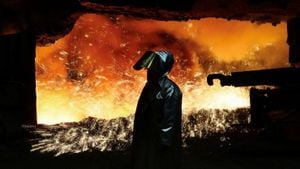New research has uncovered the surprising origins of the Altar Stone at Stonehenge, determining it came from the far north of Scotland instead of the previously believed location of south-west Wales. This significant discovery not only challenges long-held beliefs about the monument's construction but also indicates it was built with stones sourced from various regions across Great Britain.
The distance between Stonehenge and its new identified source is about 700 kilometers (434 miles). This finding suggests Neolithic Britain was more interconnected and sophisticated than previously thought.
Leading the research was Anthony Clarke, a PhD student originally from Wales, now affiliated with Curtin University in Western Australia. The results of this study have been published in the prestigious journal Nature, marking a major accomplishment for Clarke.
Despite the importance of his findings, Clarke expressed bittersweet feelings about the discovery. Jokingly he told BBC News, "I don't think I'll be forgiven by people back home. It will be a great loss for Wales!"
Interestingly, Clarke pointed out other stones at the site, known as bluestones, still come from Wales. He said, "We've got to give the Scots something! But on a serious note, Stonehenge seems to be this great British endeavor involving all the different people from all over the island."
The story of Stonehenge's materials has long intrigued archaeologists. The bluestones, identified as coming from the Preseli hills of Pembrokeshire, were first cataloged by Welsh geologist Henry Herbert Thomas in 1923.
Until recently, the Altar Stone was assumed to share its origins with these other stones. This assumption was called to question about twenty years ago when researchers began to explore its unique properties.
Another important contributor to this research was Professor Nick Pearce, also from Wales. He stated, “It blew our socks off when we discovered it was from north-east Scotland,” indicating the unexpected nature of the findings.
The analysis conducted focused on the chemical composition of rock fragments from the Altar Stone. This technique is akin to assigning fingerprints to rocks, allowing researchers to determine their specific origins.
With access to one of the largest global rock fingerprint databases, the team pinpointed the best match to be from the Orcadian Basin, which includes regions like Caithness, Orkney, and the Moray Firth. This conclusion redefines the narrative surrounding the movement and construction methods of Neolithic peoples.
Research indicates construction at Stonehenge began about 5,000 years ago, progressing over the next two millennia. Most of the bluestones are believed to be among the first stones erected at the site, establishing its historical criteria during the era.
Dr. Robert Ixer from University College London, also involved in the study, labeled the findings as “shocking.” He emphasized the mystery surrounding how the Altar Stone was transported from such great distances and speculated about the motivations behind such efforts.
Transportation of such heavy materials poses significant logistical challenges. Dr. Ixer argued, “There are obvious physical barriers to transporting by land, and an equally alarming task if going by sea,” highlighting the difficulties faced by the Neolithic people.
According to researchers, it leads to important inquiries about the social structures and transportation systems of these early communities. Prof. Pearce asserted, “These findings will have huge ramifications for our understandings of communities during Neolithic times.”
The new research findings are expected to lead to significant conversations among archaeologists, particularly those affiliated with English Heritage, which oversees Stonehenge. Senior curator Heather Sebire commented, “This discovery certainly implies there were great social connections in Britain at the time.”
She added, “It is phenomenal the people of the time brought such a large stone all this way. They must have had compelling reasons to do it.”
The mystery of Stonehenge continues to captivate not only historians and archaeologists but the general public as well. With each new piece of information, our perception of this ancient monument evolves, indicating the ingenuity of past societies.
This latest finding adds to the complex puzzle of Stonehenge's construction and significance within the broader narrative of human history. It shines light on the possibilities of cooperation and resource-sharing among the Neolithic peoples of Britain, questioning how these ancient communities interacted with their environment and each other.
Future studies will likely focus on the logistics of transporting large stones and what this means for our overall comprehension of societal organization during the Neolithic period. The Altar Stone's origin, now etched firmly as part of Scotland's geological history, opens up intriguing possibilities for how ancient peoples accomplished such monumental feats.
It's clear the more we investigate Stonehenge, the more we learn about the people who built it. Investigations such as these encourage us to rethink our views of these ancient societies and their impressive triumphs.
Experts hope to glean insights from the methodologies used to transport such large structures and assess what this reveals about their connections to each other. With this discovery now part of the narrative, the story of Stonehenge extends beyond the stones themselves to the rich history of Britain itself.
Further research is expected to address why the Altar Stone was transported over such extreme distances. This adds another layer of mystery to the enigma surrounding one of the world’s most famous monuments and the people who created it.
While the origins of the Altar Stone might not rest within Wales, Clarke's research brings new elements of discovery to the fold of Stonehenge. Investigations and collaborations may propose answers to how ancient communities not only built monuments but also how they shared resources across great distances.
The connections among the Neolithic tribes could redefine historical understandings of civilization across Great Britain. It appears the story of Stonehenge, much like its stones, is far from complete yet.
A riveting exploration continues, filled with young scholars like Clarke who are dedicated to unlocking more secrets hidden within this monumental site. Who knows what other astonishing narratives await to be uncovered about the ancient past?
Such investigations promise not only to enlighten our view of Stonehenge but also provide broader insights about early human societies and their sophisticated network of relations.



